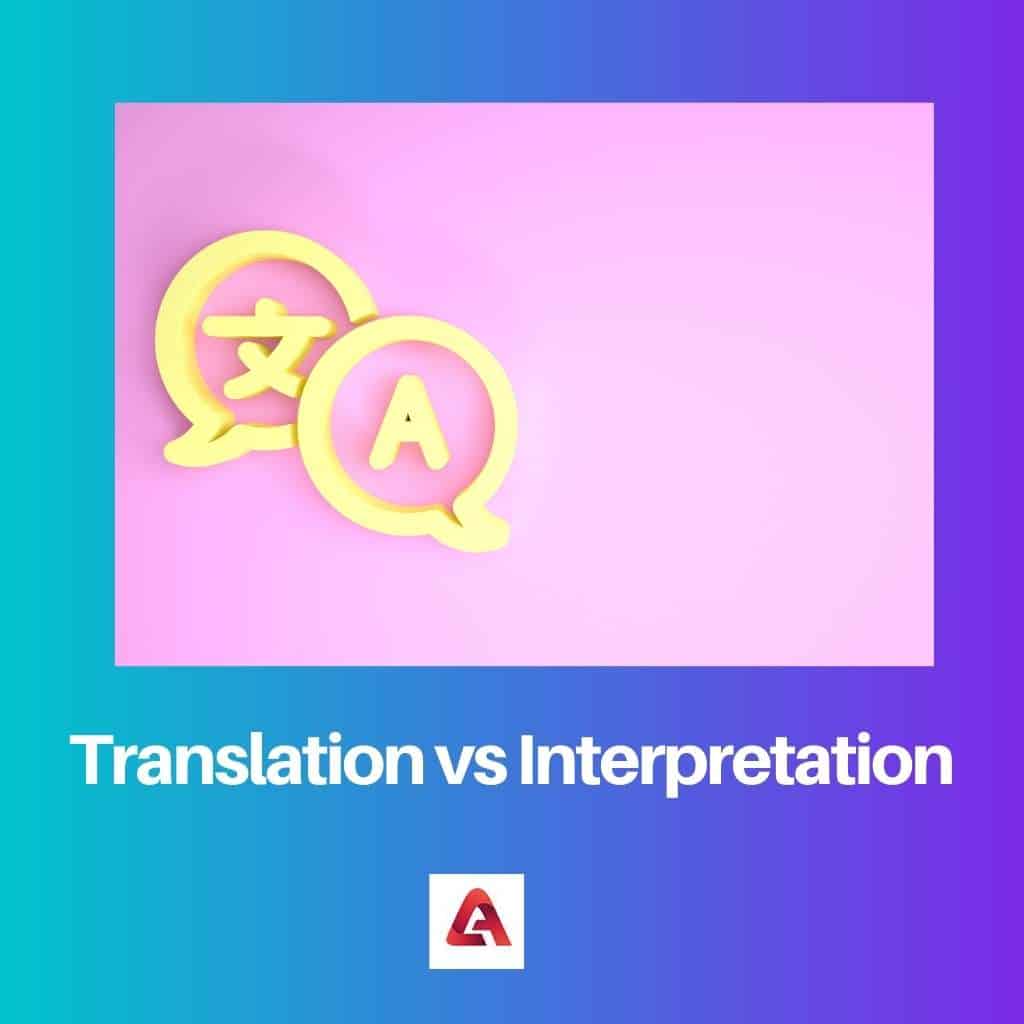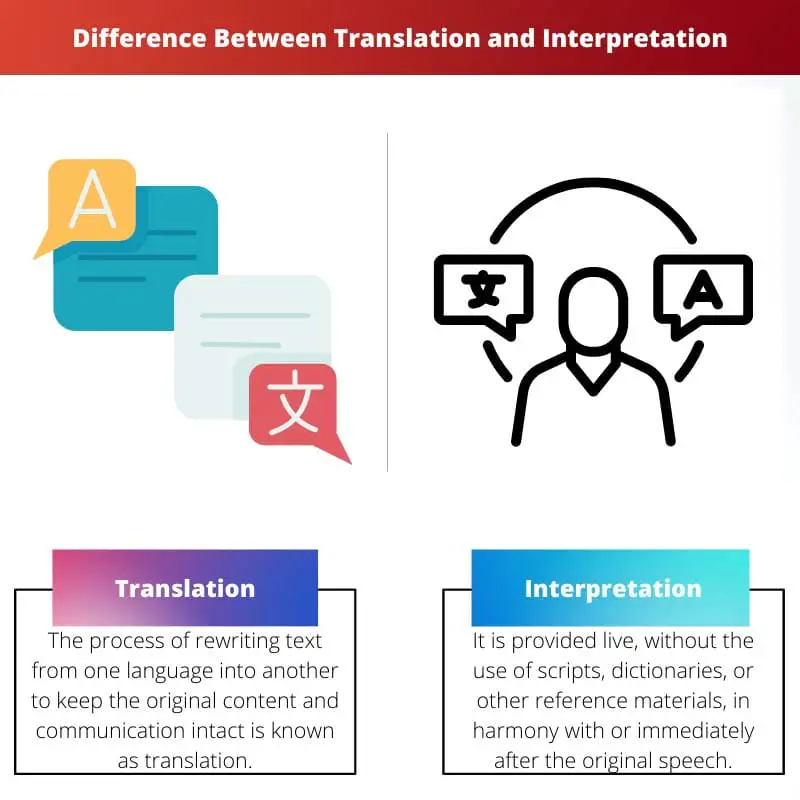From source to target, both translation and interpretation facilitate communication across languages. Translation is the process of converting the meaning of a written word from one language to another.
The meaning of a spoken word is translated from one language to another through the process of interpretation.
Translation and interpretation processes include high professionalism requirements and in-depth knowledge of the languages that one has to convert for the understanding of others.
Key Takeaways
- Translation deals with converting written text from one language to another, while interpretation focuses on oral communication.
- Translators need excellent writing skills and a deep understanding of grammar, whereas interpreters require strong listening and speaking abilities.
- Translation allows more time and resources to ensure accuracy, while interpretation demands real-time processing and communication.
Translation vs Interpretation
Translation involves using written source material, such as books, articles, or documents, and translating that material into another language. Interpretation involves the real-time conversion of spoken language from one language to another. It can take many forms, like simultaneous.

The process of transforming the written word from one language into another in a culturally and linguistically acceptable manner so that its target audience may understand it is known as language translation.
The translation process requires a highly optimized and fault-free piece of work in the required language.
The process of transforming meaning between two languages in real-time, verbally or graphically, as in the case of sign language, is known as interpretation.
The majority of interpreters work in tandem with the speakers or after the speaker has finished speaking. They are unable to express their opinions while working and must instead concentrate on correctly presenting the message and tone.
Comparison Table
| Parameters of Comparison | Translation | Interpretation |
|---|---|---|
| Format | Text-based. | Spoken language. |
| Delivery type | On the spot. | Can take place after the original text has been generated. |
| Period | Allows for plenty of time. | Do not provide time. |
| Accuracy | Takes place in one direction. | The translation is required in both directions. |
| Requirements | No such spoken form of information is required. | Important to acquire the intonation, idioms, voice modulation, and other distinguishing characteristics of the spoken word. |
What is Translation?
The process of rewriting text from one language into another to keep the original content and communication intact is known as translation.
Context, the grammatical rules of the two languages, their writing norms, and their idioms must all be considered while translating.
A widespread fallacy is that any two languages have a simple word-for-word relationship and that translation is a simple mechanical procedure.
A word-for-word translation ignores context, grammar, customs, and idioms. There are several translation methods, each with its shape and function.
When a technical product is sold in another nation, a technical translation of that particular product is essential. The technical documentation is required to be translated into the language of the relevant nation in which the product is being sold.
Legal translation is the most difficult translation, and it includes marriage and birth certificate translations, as well as contracts, memorandums, agreements, wills, and such documents.
A competent translator must comprehend the document’s many underlying texts as well as the laws of the two nations or areas for which the papers are required.
For book translation, a strong command of the target and source languages is required. Only someone who understands the significance of the book’s original tone can accurately interpret it.
The enormous crowd of the entire planet may be captured with the help of book translation.
A medical translation includes a wide range of topics in the medical profession, including pharmaceutical product translations, translations of critical product information for medical equipment and research results, and patient clinical information and notes.
The task of translating patent documents into another language is known as patent translation.
Legal professionals most likely prepare patent translations. The patent translation should be such that it may be understood by someone who has never heard of the invention before.
A tiny blunder can make or destroy a contract, thus translation should be handled with extreme caution.

What is Interpretation?
Interpretation is a service that is provided in real-time. It is provided live, without the use of scripts, dictionaries, or other reference materials, in harmony with or immediately after the original speech.
Professional interpreters must transpose the source language into context, keeping the original meaning intact while rephrasing idioms, colloquialisms, and other culturally unique allusions in a way that the target audience can comprehend.
Experience, a good memory, and fast reactions are an interpreter’s sole assets. The underlying ‘rule’ of language interpretation is the preservation and registration of the meaning of the original language material, which encompasses sign, spoken, and written discourses.
There are various types of interpretation.
In simultaneous interpretation, the interpreter wears headphones and listens to the spoken content while speaking the interpreted words into a microphone.
The interpreter begins their interpretation process as soon as they comprehend the sentence’s overall meaning. Award presentations and beauty pageants are great examples of simultaneous interpretation.
Surprisingly, the Nuremberg Trials were the first to employ simultaneous interpretation utilizing technological devices. In consecutive interpretation, the speaker talks for a short period before pausing for about five minutes.
During the halted period, the interpreter makes notes and transfers the message.
Note-taking is an important skill in consecutive interpretation. Liaison interpretation relies on an interpreter who continuously translates between the source and target languages while the discussion is in progress.
This sort of interpretation is best for small, casual gatherings.
Main Differences Between Translation and Interpretation
- While interpretation deals with spoken language in instant time, translation includes text-based services.
- Interpretation is an on-the-spot service. The meeting might occur in person, over the telephone, or via video call. On the other hand, translation can take place after the original text has been generated.
- In general, the translation process allows for plenty of time to use technology and references resources to manufacture accurate and high-quality translations, whereas on the other hand interpretation process is an instant event that does not provide time for factors like accuracy and quality.
- Because interpretation is a process in which translation is required in both directions instantly without the use of reference sources, the interpreter must be proficient in both the source and destination languages. The translation process only happens in one direction.
- In Interpretation, it is important to acquire the intonation, idioms, voice modulation, and other distinguishing characteristics of the spoken word and then communicate these verbal clues to the client, whereas in translation, no such criteria are required to be fulfilled.

- http://www.berkeleymonastery.org/uploads/6/3/3/1/6331706/on_translation.pdf
- https://www.cambridge.org/core/journals/annual-review-of-applied-linguistics/article/abs/translation-and-interpretation/0854326094B265104925C60E9342EE6D

I appreciate the detailed explanation on simultaneous interpretation and the historical context. Great work!
I’m afraid the article is oversimplifying the complexity of interpretation. It’s not just about verbal clues but about capturing the whole meaning.
The article provides an excellent understanding of the requirements and differences between translation and interpretation.
I found it very informative and interesting. A great article for those wanting to learn more about translation and interpretation.
The information on the translation and interpretation process was very clear and well explained.
This article was a very insightful read on the differences between translation and interpretation. I especially liked the clear comparison table.